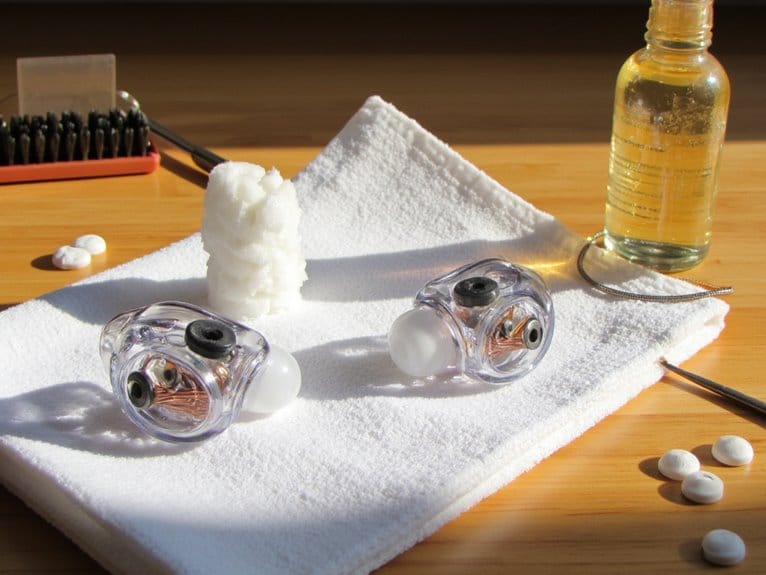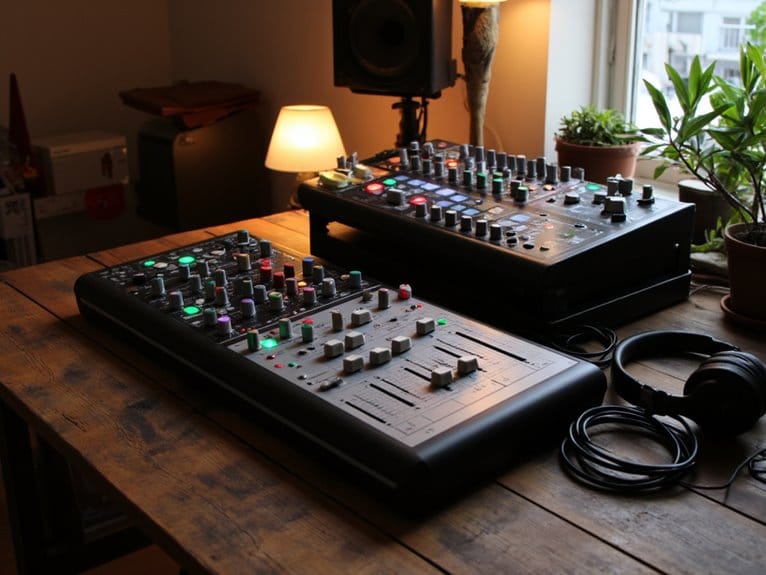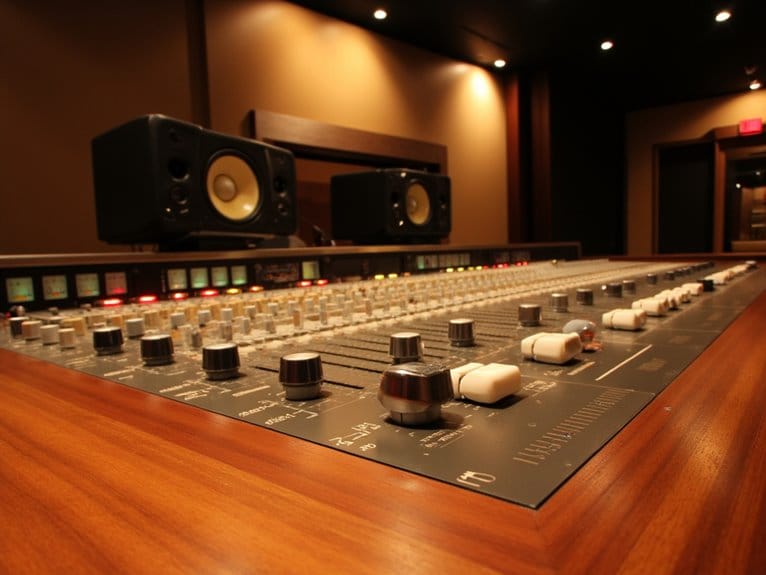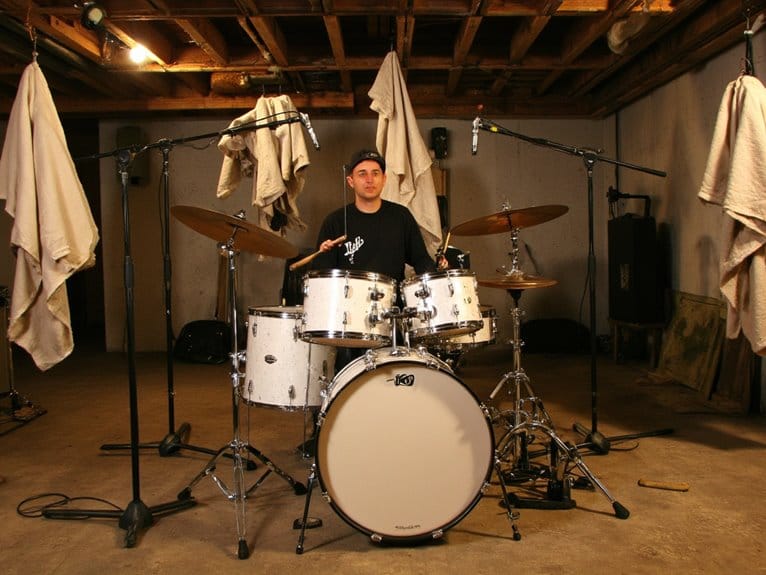How to Maintain and Care for In-Ear Monitors
You’ll keep your in-ear monitors performing at their best by wiping down surfaces after each use with microfiber cloths, cleaning ear tips weekly with alcohol wipes, and holding IEMs nozzle-down during maintenance to let debris fall out naturally. Store them in hard cases with desiccant packs to prevent moisture damage, inspect cables monthly for wear near connectors, and replace filters as needed to maintain sound quality. Proper care prevents the channel imbalance and connector failures that plague neglected units.
We are supported by our audience. When you purchase through links on our site, we may earn an affiliate commission, at no extra cost for you. Learn more.
Notable Insights
- Clean IEMs after each use by wiping external surfaces and holding nozzles downward during maintenance.
- Use specialized cleaning tools including wire loops for wax removal and soft-bristled brushes for dust.
- Sanitize ear tips weekly with alcohol wipes and perform bi-weekly deep cleaning with warm soapy water.
- Handle cables carefully by grasping connectors when disconnecting and avoiding sharp bends near connection points.
- Store IEMs in hard protective cases with desiccant packs in cool, dry locations away from heat.
Essential Cleaning Procedures for Optimal Performance
Three simple cleaning habits will dramatically extend your in-ear monitors’ lifespan and preserve their sound quality, though I’ll admit it took me years of costly mistakes to learn this lesson properly.
Your post-session routine should include wiping down the external surfaces with Tech-Care Clean wipes or microfiber cloths, removing sweat and earwax that can corrode components over time.
Regular surface cleaning with proper wipes and microfiber cloths prevents corrosive sweat and earwax buildup that destroys expensive components.
These cleaning techniques prevent acidic buildup from damaging delicate drivers and filters inside your investment.
Hold your IEMs with nozzles facing downward during maintenance, allowing debris to fall out naturally rather than pushing deeper into sensitive areas.
Weekly performance optimization sessions should focus on nozzle inspection and ear tip cleaning, using soft-bristled brushes designed specifically for audio equipment rather than cotton swabs that risk internal damage. After cleaning, store your IEMs in a dry case to prevent moisture buildup and protect against environmental damage.
Clean your IEMs at least once or twice weekly to prevent channel imbalance and maintain optimal sound performance.
Required Tools and Accessories for Proper Maintenance
While proper cleaning techniques form the foundation of IEM care, you’ll need specific tools to execute these procedures effectively, and I’ve learned through trial and error that generic household items simply don’t cut it for precision audio equipment.
Professional cleaning tools, typically featuring wire loops and brushes in affordable packs under $6, target wax buildup and debris without damaging delicate sound ports.
I’ve found that protective ear gel lubricants enhance comfort while extending tip lifespan, though applying them sparingly prevents dirt attraction.
Essential maintenance accessories include:
- Specialized cleaning tool sets with wire loops for wax removal and brushes for dust particles
- Antibacterial wipes designed for electronics to sanitize surfaces between uses safely
- Protective storage cases with padded compartments for organized transport and moisture protection
For wireless IEM systems, maintaining proper battery care becomes crucial since limited battery life can require frequency changes during extended worship services or performances.
Proper care and cleaning practices significantly impact the longevity of detachable cables, especially MMCX connectors which can experience durability issues under heavy use.
Hygienic Practices to Prevent Contamination
Beyond simply having the right tools, establishing consistent hygienic practices becomes the cornerstone of preventing contamination that can compromise both your health and your IEMs’ performance. The hygiene importance cannot be overstated, as ear tip sanitization directly impacts both sound quality and your wellbeing.
| Cleaning Task | Frequency |
|---|---|
| Alcohol wipes on ear tips | Weekly |
| Warm soapy water submersion | Bi-weekly |
| Storage case cleaning | Monthly |
| Filter replacement | As needed |
I’ve learned that handling IEMs by their housing, rather than cables, reduces contamination while preventing damage. You’ll want to wipe down your monitors with microfiber cloth after each use, removing sweat and oils that degrade hygiene. Never share IEMs with others, and avoid wearing them during intense workouts unless they’re water-resistant. Proper seal maintenance with ear tips also protects your hearing from prolonged exposure to high volumes while maintaining the 35dB+ noise isolation that quality in-ear monitors should provide.
Routine Maintenance Schedules and Inspections
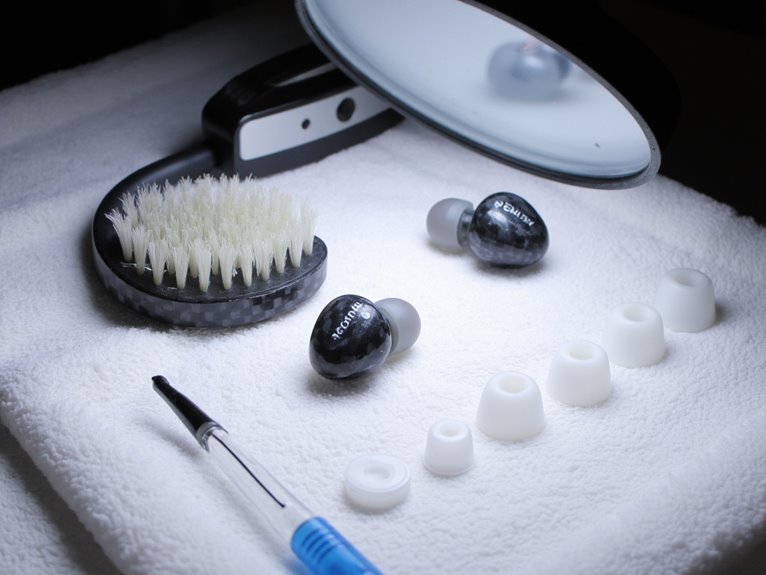
Since I’ve been using in-ear monitors professionally for over a decade, I can’t stress enough how a structured maintenance routine will dramatically extend your IEMs’ lifespan while preserving their sonic accuracy. Establishing proper routine frequency guarantees you’ll catch problems before they become expensive repairs, while consistent inspection methods help identify wear patterns that could compromise sound quality.
| Maintenance Type | Frequency | Key Focus Areas |
|---|---|---|
| Daily Cleaning | After each use | Ear tips, sound bores, external surfaces |
| Weekly Inspection | Every 7 days | Cables, connectors, filters, housing integrity |
| Monthly Deep Clean | 30-day intervals | Internal components, damper tubes, silica gel replacement |
| Professional Service | 6-12 months | Recalibration, component replacement, internal cleaning |
This systematic approach prevents the gradual degradation that ruins countless IEMs through neglect. Quality ear tips made from silicone or memory foam require special attention during maintenance since they’re crucial for maintaining both comfort and the noise isolation capabilities that can block up to 38 dB of ambient noise.
Troubleshooting Common Care and Maintenance Issues
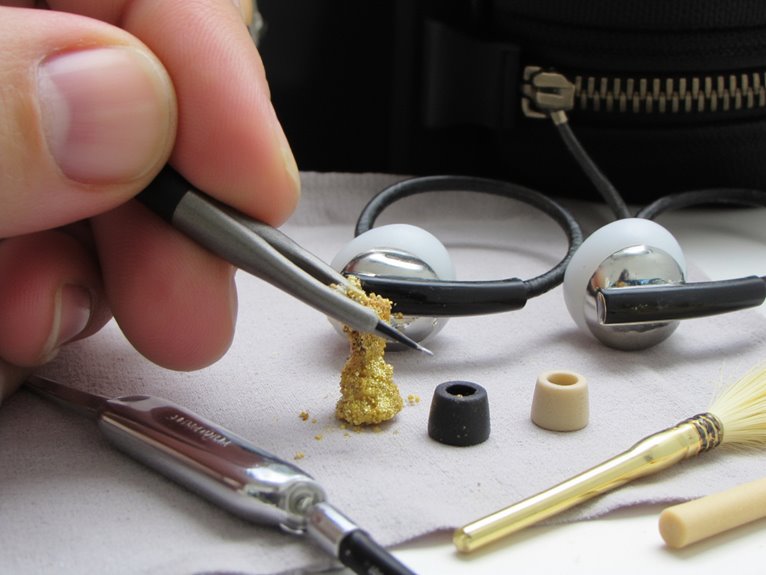
Three fundamental categories of IEM problems account for roughly 90% of the troubleshooting calls I’ve handled over the years, and I can tell you that most of these issues stem from preventable maintenance oversights rather than actual equipment failures.
Most IEM failures aren’t actually equipment breakdowns-they’re simply maintenance mistakes that could have been easily prevented with proper care.
When you’re audio testing and notice problems, start with these systematic checks:
- Sound interruption and connectivity – Inspect cable connectors for secure installation, check sound ports for earwax blockages, and examine headphone jacks for debris that disrupts signal flow.
- Bass loss and audio quality degradation – Verify proper seal by adjusting fit deeper into your ear canal, clean clogged sound ports carefully, and test different ear tip sizes.
- Physical damage prevention – Store IEMs in protective cases, avoid cable kinks, and perform weekly cleaning with specialized brushes rather than cotton swabs.
Frequently Asked Questions
How Often Should I Replace the Ear Tips on My IEMS?
Replace your IEM ear tips every 3-6 months for ideal hygiene and sound quality. Different ear tip materials like foam degrade faster than silicone, while various ear tip types have specific replacement schedules recommended by manufacturers.
What Should I Do if My IEMS Get Wet or Soaked?
If your IEMs get wet, immediately shake out excess water, remove detachable parts, and avoid powering on. Use proper drying techniques like silica gel packets and air-dry for 24-72 hours. Consider moisture prevention sprays afterward.
Are There Specific Cleaning Products I Should Avoid Using on IEMS?
You should avoid harmful solvents like bleach, chlorine cleaners, and harsh detergents that damage IEM materials. Skip oil-based substances and household sprays. Stick to recommended cleaners: diluted isopropyl alcohol and microfiber cloths for safe cleaning.
On a final note
You’ve now got the complete toolkit for keeping your in-ear monitors performing at their peak, and honestly, it’s not rocket science once you establish these habits. Regular cleaning, proper storage, and consistent maintenance schedules will extend your IEMs’ lifespan considerably while preserving their acoustic integrity. Don’t overthink it-just stay consistent with these practices, and you’ll enjoy crisp, reliable audio for years to come.

